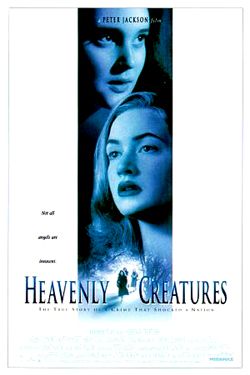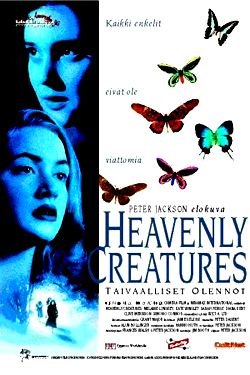← Back to Reviews
in
Plot – Heavenly Creatures details a true life murder that rocked the nation of New Zealand, and made headlines all over the world in 1954. Two young girls, Pauline Parker (Lynskey) and Juliet Hulme (Winslet), form an intensely close friendship in 1950s New Zealand which would eventually result in the murder of Parker's mother. The two girls formed a vividly real and elaborate fantasy world where they felt happier than they did in normal life. When their friendship and the fantasy are threatened by the possibility of them being parted, the two girls come up with an unspeakably disturbing idea that would ensure they remained together - to remove the obstacle that was Pauline's mother.
I think Heavenly Creatures is really quite a rare film. It's a film that achieves the rare accomplishment of being both beautiful and horrific. Telling the true story of close friends Pauline Parker and Juliet Hulme; two teenage girls who murdered Pauline's mother in an attempt to keep them from being separated, it takes a potentially difficult and undoubtedly troubling subject but tells it wonderfully with a real grace and artistry. I always find a case like this to be darkly fascinating, a case where you get that incredible phenomenon of folie a deux. I'm always amazed when such unique and troubled individuals are able to find each other, and form a connection; whether it be friend or lovers or whatever. And sadly when they do so it usually spells trouble for anyone in their path.
Given the nature of its subject matter it's a film that could very easily fall apart if the young actresses portraying the two central roles weren't up the task. Thankfully Heavenly Creatures has no need to worry about that, featuring as it does two terrific showings from Kate Winslet and Melanie Lynskey. Both just teenagers at the time, what they were able to accomplish is really very impressive. Amazingly it was the feature film debut for both actresses, and for Lynskey (just 16 at the time) this was actually her first acting gig whatsoever. As well as great credit for the two ladies themselves, credit must go to Jackson and whoever else was involved in unearthing such two gems.
Inhabiting two quite disparate characters, Winslet and Lynskey deliver two dynamic and fearless performances. Winslet imbues Juliet with quite an ebullient and dramatic character, full of charisma; someone comfortable as the centre of attention. While Lynskey's Pauline is a much more moody, sour faced and brooding individual; the classic outcast. Together however they find in each other a kindred spirit, or even a soulmate of sorts. The friendship they create is alluring, and we really feel for them when they display the hysterical pain they feel when the threat of losing each other looms over them. Indeed in many ways Jackson eschews the typical crime film facets that you may expect to find here, instead choosing to focus on the incredible friendship that these two characters shared and how dark a direction it sadly took.
The film's greatest success (amongst its many successes) is in its ability to place us in the minds of these two girls who committed such an unspeakable act. While we never get to the stage of sympathising with the girls the film successfully relates and helps us understand why it happened. By contrasting their real lives with the fantasy world that they have created, we understand why the fantasy world begins to bleed through into reality for the girls, and why they go to such lengths to try and realise it. We are made to see events through the eyes of the girls; to see how harsh and cruel the treatment at the hands of their parents appears to them, and how welcome a refuge their fantasy world is for these two unique souls. Bonded by similar experiences in childhood (Juliet suffered from tuberculosis, while Pauline suffered from osteomyelitis) which left both of them bedridden for much of their early years, they struggle to find their place in the world until they meet each other and create their own religion of a sort, constructing a fantasy world they call The Fourth World. They believed that they could enter this dimension through a spiritual enlightenment they gained as a result of the friendship.
Peter Jackson does a terrific job at presenting the contrast of these worlds through his visuals. The fantasy scenes are just as the girls would see them; beautiful, enchanting and really quite ethereal. The world is classic fairytale stuff. And inhabiting this world are the archetypal characters and situations of such a world – kings and queens, marriages and murders. The girls write down these stories and create the characters in clay. Jackson follows suit by giving us full-size clay figures for the girls to interact with in their delusions; giving them quite a quaint and fanciful feel to the scenes. Back in 1994 the special effects may have been a fine example of the current technology but now look a little dated. But I actually think that helps the film. It gives them more of a homemade vibe which fits with the idea of it being creations of the girls, just as the clay figures are.
In absolute contrast to this beautiful fantasy however is the grim reality of what actually happened, and that likewise is presented in a stirring fashion by Jackson. The sequence which depicts the actual murder of Pauline's murder is powerful, disturbing and immensely affecting. It sees the two girls and Pauline's mother walking along a wildlife trail, and is a very eerie and tense experience. The wait is absolutely brutal. With the characters walking in silence as a beautiful but haunting piece of score music plays, the scene seems to take an absolute age before arriving at its inevitable conclusion. And the sounds that the mother makes after she is cracked over the head are bone-chilling; a mix of pain, shock and the stupefying effect of the blow. It's a unnervingly animal like shriek. And the scene has so much more impact than any gory, convoluted death in trash like Saw or Hostel ever could.
1994 is a highly revered year in cinema. A year often listed as one of the the absolute greats, certainly in the modern era at least. It was a year that saw the release of numerous big hitters and perennial favourites - Pulp Fiction, Leon, Shawshank Redemption, Ed Wood, Forrest Gump, Lion King, Speed, Natural Born Killers, The Crow, Hoop Dreams etc. Well I certainly feel that Heavenly Creatures deserves its place amongst those.
Conclusion - This was the film that proved to be Peter Jackson's calling card for Hollywood, and it isn't hard to see why. It's a bold and visionary piece of film-making. The first time I saw this film it was one of those that really stuck with me for a considerable time, and while its effect may have slightly lessened on repeated viewings, that still holds true. A powerful film.

|

|
Year of release
1994
1994
Directed by
Peter Jackson
Peter Jackson
Written by
Fran Walsh
Peter Jackson
Fran Walsh
Peter Jackson
Starring
Kate Winslet
Melanie Lynskey
Sarah Peirse
Diane Kent
Clive Merrison
Kate Winslet
Melanie Lynskey
Sarah Peirse
Diane Kent
Clive Merrison
Heavenly Creatures
Plot – Heavenly Creatures details a true life murder that rocked the nation of New Zealand, and made headlines all over the world in 1954. Two young girls, Pauline Parker (Lynskey) and Juliet Hulme (Winslet), form an intensely close friendship in 1950s New Zealand which would eventually result in the murder of Parker's mother. The two girls formed a vividly real and elaborate fantasy world where they felt happier than they did in normal life. When their friendship and the fantasy are threatened by the possibility of them being parted, the two girls come up with an unspeakably disturbing idea that would ensure they remained together - to remove the obstacle that was Pauline's mother.
I think Heavenly Creatures is really quite a rare film. It's a film that achieves the rare accomplishment of being both beautiful and horrific. Telling the true story of close friends Pauline Parker and Juliet Hulme; two teenage girls who murdered Pauline's mother in an attempt to keep them from being separated, it takes a potentially difficult and undoubtedly troubling subject but tells it wonderfully with a real grace and artistry. I always find a case like this to be darkly fascinating, a case where you get that incredible phenomenon of folie a deux. I'm always amazed when such unique and troubled individuals are able to find each other, and form a connection; whether it be friend or lovers or whatever. And sadly when they do so it usually spells trouble for anyone in their path.
Given the nature of its subject matter it's a film that could very easily fall apart if the young actresses portraying the two central roles weren't up the task. Thankfully Heavenly Creatures has no need to worry about that, featuring as it does two terrific showings from Kate Winslet and Melanie Lynskey. Both just teenagers at the time, what they were able to accomplish is really very impressive. Amazingly it was the feature film debut for both actresses, and for Lynskey (just 16 at the time) this was actually her first acting gig whatsoever. As well as great credit for the two ladies themselves, credit must go to Jackson and whoever else was involved in unearthing such two gems.
Film trivia – Peter Jackson employed a number of factors as he strived for authenticity where possible. The voice-over readings that Melanie Lynskey provided from her character's diary were actually word for word extracts from Pauline Parker's own diary from that time, uncovered during the police investigation and a large part of the trial. The film was also shot almost exclusively at genuine locations were the real events actually transpired. This included visiting the actual spot where the murder occurred. According to Jackson, when they got there it was eerily quiet; all of the birds stopped singing and the place just did not feel right. As a result they moved the filming a couple of hundred yards along the path.
The film's greatest success (amongst its many successes) is in its ability to place us in the minds of these two girls who committed such an unspeakable act. While we never get to the stage of sympathising with the girls the film successfully relates and helps us understand why it happened. By contrasting their real lives with the fantasy world that they have created, we understand why the fantasy world begins to bleed through into reality for the girls, and why they go to such lengths to try and realise it. We are made to see events through the eyes of the girls; to see how harsh and cruel the treatment at the hands of their parents appears to them, and how welcome a refuge their fantasy world is for these two unique souls. Bonded by similar experiences in childhood (Juliet suffered from tuberculosis, while Pauline suffered from osteomyelitis) which left both of them bedridden for much of their early years, they struggle to find their place in the world until they meet each other and create their own religion of a sort, constructing a fantasy world they call The Fourth World. They believed that they could enter this dimension through a spiritual enlightenment they gained as a result of the friendship.
Peter Jackson does a terrific job at presenting the contrast of these worlds through his visuals. The fantasy scenes are just as the girls would see them; beautiful, enchanting and really quite ethereal. The world is classic fairytale stuff. And inhabiting this world are the archetypal characters and situations of such a world – kings and queens, marriages and murders. The girls write down these stories and create the characters in clay. Jackson follows suit by giving us full-size clay figures for the girls to interact with in their delusions; giving them quite a quaint and fanciful feel to the scenes. Back in 1994 the special effects may have been a fine example of the current technology but now look a little dated. But I actually think that helps the film. It gives them more of a homemade vibe which fits with the idea of it being creations of the girls, just as the clay figures are.
Film trivia – Well not so much film trivia, as the facts of the true case. Following a sensational and high-profile trial, the girls were both convicted of the murder and spent five years in prison. A condition of their release was that they would never see each other again. At the time of the film's release it was discovered that Juliet Hulme had actually achieved a highly successful career as a crime novelist, using the name Anne Perry. Both ladies now live thousands of miles away from the location where the murder took place, and yet apparently and amazingly live just 90 miles apart by pure coincidence; both in Scotland. Perry lives in the village of Portmahomack, while Parker (who now goes by Hilary Nathan) lives on one of the Orkney islands.
1994 is a highly revered year in cinema. A year often listed as one of the the absolute greats, certainly in the modern era at least. It was a year that saw the release of numerous big hitters and perennial favourites - Pulp Fiction, Leon, Shawshank Redemption, Ed Wood, Forrest Gump, Lion King, Speed, Natural Born Killers, The Crow, Hoop Dreams etc. Well I certainly feel that Heavenly Creatures deserves its place amongst those.
Conclusion - This was the film that proved to be Peter Jackson's calling card for Hollywood, and it isn't hard to see why. It's a bold and visionary piece of film-making. The first time I saw this film it was one of those that really stuck with me for a considerable time, and while its effect may have slightly lessened on repeated viewings, that still holds true. A powerful film.
